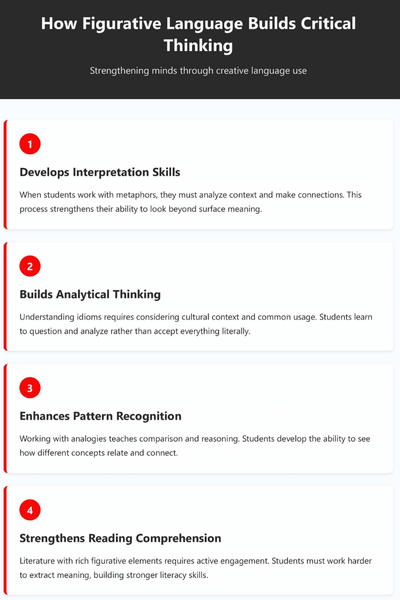
Figurative language is everywhere. You hear it in songs, read it in books, and use it daily. Phrases like “break the ice” or “time is a thief” give description through analogy, shaping interpretation so we say more with less.
But why does figurative language matter so much? It turns basic words into powerful messages. It adds emotion and depth to communication. For teens and students, mastering language through metaphors and idioms opens doors to better understanding.
What Is Figurative Language?

Figurative language uses words in creative ways. It goes beyond literal meaning to create specific effects. Instead of saying exactly what we mean, we use comparisons or imagery to paint mental pictures.
Think about calling someone “a walking encyclopedia.” You’re using a metaphor to show they’re smart. This figurative expression makes your point memorable. That’s one example of figurative language at work.
Common figures of speech include metaphor, simile, idiom, personification, hyperbole, symbolism, alliteration, and onomatopoeia. Each type serves a purpose in language use.
A metaphor makes a direct comparison. “Time is a thief” suggests time steals moments from our lives. This interpretation adds depth and links abstract ideas with concrete images.
A simile uses “like” or “as” to compare things. “She runs like the wind” helps readers visualize speed. Similes make understanding easier by connecting new ideas to familiar ones. A simile creates clear imagery through comparison.
An idiom is a phrase with figurative meaning. “It’s a piece of cake” means something is easy. These expressions require interpretation beyond literal words. Understanding an idiom helps with language comprehension.
Personification gives human traits to non-human things. “The wind whispered through the trees” creates imagery and emotion through personification.
Hyperbole uses exaggeration for emphasis. “I’ve told you a million times” stresses a point. Nobody means this literally, yet the hyperbole makes the message clear.
Symbolism uses objects to represent deeper meanings. A dove symbolizes peace. This symbolism invites exploration of connotation and nuances.
Alliteration repeats starting sounds. “Busy as a bee” uses alliteration to create rhythm and memorability. This device works well in poetry.
Onomatopoeia imitates sounds like “buzz” or “sizzle.” It creates vivid writing that pulls readers in.
These language expressions act as tools. They turn plain sentences into ones that spark imagination and create resonance.
How Figurative Language Enriches Writing

Good writing needs more than facts. Figurative language brings writing to life. Authors use this language technique to help readers form mental images. This creates experiences rather than just information.
A metaphor transforms simple sentences. “Her smile was sunshine” tells us about warmth and happiness. That’s the power of figurative description. Using a metaphor adds layers of meaning to writing.
Imagery through figurative language engages imagination. It makes storytelling compelling. This kind of language use conveys deeper meanings and emotional nuances. Readers connect with texts on an emotional level through figures of speech.
Figurative language shapes writing voice and writing style. How an author uses analogy gives their work unique flavor. This creativity keeps reader interest high. An analogy helps readers remember key points long after reading.
Writing tips often stress using these devices. A metaphor adds color and depth to writing. They turn flat prose into something alive. Well-placed figures of speech create mental snapshots.
In persuasive writing, an analogy drives points home. It helps audiences grasp complex ideas through familiar comparisons. This improves comprehension and makes messages stick.
Figurative language makes writing memorable. It invites interpretation and engagement. This turns writing into expression that touches both mind and heart.
The Role of Figurative Language in Everyday Speech
We use figurative language constantly. Daily conversations overflow with idioms. “I’m swamped” or “hang in there” pepper our talk. These add personality to communication.
Speaking with figurative language makes conversations engaging. It adds humor and emphasis. When you say “I’m so hungry I could eat a horse,” everyone understands your feeling.
Figurative language helps us be polite. Instead of harsh statements, we soften messages. This shows how language affects communication.
Understanding figurative expressions matters for social success. Missing the meaning of an idiom can lead to confusion. It can make social situations awkward.
Cultural literacy depends on knowing common phrases. When someone says “the ball’s in your court,” they expect you to know what that means. These shared expressions create connections.
Figurative language also allows emotional expression. Sometimes feelings are hard to describe literally. Saying “my heart sank” communicates emotions vividly. This makes communication skills stronger.
For young people developing language skills, learning figurative speech is crucial. It affects how they understand media and connect with peers. Mastering figures of speech opens fuller participation in social life.
Figurative Language and Critical Thinking Development

Working with figurative language builds thinking skills. When students encounter a metaphor, they must interpret it. This requires analyzing context. That process strengthens critical thinking development.
Understanding an idiom means going beyond surface meaning. You need to consider cultural context. This develops analytical abilities. Students learn to look for deeper meaning in language.
Poetry especially requires this thinking. Symbolism forces readers to engage actively. They must question what images represent. This active interpretation builds mental flexibility.
Analogies teach comparison and reasoning. An analogy shows how different things relate. You develop pattern recognition. An analogy transfers skills to other problem solving areas. Using an analogy well requires insight into relationships.
Creating figurative language demands creativity. Students who craft their own similes exercise imagination. They practice seeing relationships between ideas.
Reading literature with rich figurative elements improves reading comprehension. Students must work harder to extract meaning. This builds literacy skills over time.
Teachers use figurative language examples to discuss multiple meanings. This shows students that language has depth. Grasping this complexity prepares them for advanced texts.
Research supports that figurative language work enhances development. Students who master these concepts show stronger literacy. They demonstrate better understanding across subjects.
Supporting Teens with Figurative Language Challenges
Some teenagers struggle with figurative language. They might take language literally. This creates difficulties in school and social settings. It’s a common issue needing support.
Teens with these challenges might not understand jokes. They could misinterpret instructions with common expressions. This affects confidence and peer connections.
Speech therapy can help tremendously. Therapists know how important figurative language is for teen communication. Many programs include work on non-literal language forms and language use.
Therapists use various methods to teach these skills. They practice interpretation through games. Using song lyrics makes language lessons engaging.
The goal goes beyond memorizing phrases. Teens need to learn interpretation of new expressions from context. This trains their brains to catch cues. With practice, they become comfortable with language expressions.
Language activities help make learning fun. Comparing literal and figurative meanings creates learning moments. Reading together builds skills gradually.
Parents can support this learning. Explain expressions when they come up naturally. Creating a safe space for language exploration helps teens ask for clarification.
Research shows difficulties with figurative language affect outcomes. But targeted support makes a difference. Teens who improve their grasp see better comprehension and communication.
Professional help gives teens structured practice. Programs often integrate figurative language work with other language skills. This addresses development needs effectively.
With support, teenagers can master figurative language. This unlocks communication competence. The importance of this work cannot be overstated.
Take Action to Strengthen Language Skills

Don’t wait to address challenges with figurative language. If your teen struggles with language interpretation, reach out today. Our speech therapy programs include targeted work on all figurative expressions. We make language lessons engaging through language activities that build communication skills.
Contact us to schedule an evaluation. Our therapists will assess your teen’s abilities and create a personalized plan. We focus on practical communication that translates to success.
Strong skills open doors to better opportunities. Give your teen the tools they need to understand and use language effectively. Call us today to learn how speech therapy can help your teenager thrive.
Frequently Asked Questions
What are the main types of figurative language?
The main types include metaphor, simile, idiom, personification, hyperbole, symbolism, alliteration, and onomatopoeia. Each type uses language in creative ways to add depth and richness to communication beyond literal meaning.
Why do students need to learn figurative language?
Students need figurative language for reading comprehension, writing quality, and social communication. Most literature and many academic texts use figurative expressions, and understanding them is crucial for literacy and academic success.
How can I help my teen understand idioms better?
Explain idioms when they come up in conversation and encourage questions about unfamiliar phrases. Reading together and discussing language examples helps, as does creating a safe space where your teen feels comfortable asking for clarification.
At what age should children understand figurative language?
Children start grasping simple metaphors and similes around age 5 to 7. Understanding of idioms and more complex figurative language develops through elementary and middle school years, with full mastery typically occurring in adolescence.
